Acute Effects of Work Rest Interval Duration of 3 HIIT Protocols on Cycling Power in Trained Young Adults
Abstract
1. Introduction
2. Materials and Methods
2.1. Study Design
2.2. Participants
2.3. Training Intervention
2.4. Anthropometric Measurements
2.5. Physical Measurements Control
2.6. Physical Measurements Experimental
2.7. Statistical Analysis
3. Results
4. Discussion
5. Conclusions
Author Contributions
Funding
Institutional Review Board Statement
Informed Consent Statement
Data Availability Statement
Conflicts of Interest
References
- Buchheit, M.; Laursen, P.B. High-intensity interval training, solutions to the programming puzzle: Part I: Cardiopulmonary emphasis. Sports Med. 2013, 43, 313–338. [Google Scholar] [CrossRef]
- Azuma, K.; Matsumoto, H. Potential Universal Application of High-intensity Interval Training from Athletes and Sports Lovers to Patients. Keio J. Med. 2017, 66, 19–24. [Google Scholar] [CrossRef] [PubMed]
- Gibala, M.J.; Little, J.P.; MacDonald, M.J.; Hawley, J.A. Physiological adaptations to low volume, high intensity interval training in health and disease. J. Physiol. 2012, 590, 1077–1084. [Google Scholar] [CrossRef]
- Billat, V.L.; Slawinski, J.; Bocquet, V.; Demarle, A.; Lafitte, L.; Chassaing, P. Intermittent runs at the velocity associated with maximal oxygen uptake enables subjects to remain at maximal oxygen uptake for a longer time than intense but submaximal runs. Eur. J. Appl. Physiol. 2000, 81, 188–196. [Google Scholar] [CrossRef] [PubMed]
- Laursen, P.B.; Jenkins, D.G. The scientific basis for high-intensity interval training: Optimizing training programs and maximizing performance in highly trained endurance athletes. Sports Med. 2002, 32, 53–73. [Google Scholar] [CrossRef] [PubMed]
- Seiler, S.; Sjursen, J.E. Effect of work duration on physiological and rating scale of perceived exertion responses during self-paced interval training. Scand. J. Med. Sci. Sports 2004, 14, 318–325. [Google Scholar] [CrossRef]
- Stølen, T.O.; Høydal, M.A.; Kemi, O.J.; Catalucci, D.; Ceci, M.; Aasum, E.; Larsen, T.; Rolim, N.; Condorelli, G.; Smith, G.L.; et al. Interval training normalizes cardiomyocyte function, diastolic Ca2+ control, and SR Ca2+ release synchronicity in a mouse model of diabetic cardiomyopathy. Circ. Res. 2009, 105, 527–536. [Google Scholar] [CrossRef]
- Tschakert, G.; Hofmann, P. High-intensity intermittent exercise: Methodological and physiological aspects. Int. J. Sport Physiol. Perform. 2013, 8, 600–610. [Google Scholar] [CrossRef]
- Hawley, J.A.; Myburgh, K.H.; Noakes, T.D.; Dennis, S.C. Training techniques to improve fatigue resistance and enhance endurance performance. J. Sport Sci. 1997, 15, 325–333. [Google Scholar] [CrossRef]
- Hawley, J.A.; Stepto, N.K. Adaptations to training in endurance cyclists: Implications for performance. Sport Med. 2001, 31, 511–520. [Google Scholar] [CrossRef]
- Hofmann, P.; Tschakert, G. Special needs to prescribe exercise intensity for scientific studies. Cardiol. Res. Pract. 2010, 2011, 209302. [Google Scholar] [CrossRef]
- Weston, K.S.; Wisløff, U.; Coombes, J.S. High-intensity interval training in patients with lifestyle-induced cardiometabolic disease: A systematic review and meta-analysis. Br. J. Sports Med. 2014, 48, 1227–1234. [Google Scholar] [CrossRef] [PubMed]
- Follador, L.; Alves, R.C.; Ferreira, S.D.; Buzzachera, C.F.; Andrade, V.S.; Garcia, E.D.; Osiecki, R.; Barbosa, S.C.; Oliveira, L.M.; Silva, S.G. Physiological, Perceptual, and Affective Responses to Six High-Intensity Interval Training Protocols. Percept. Mot. Skills 2018, 125, 329–350. [Google Scholar] [CrossRef]
- Seiler, S.; Jøranson, K.; Olesen, B.V.; Hetlelid, K.J. Adaptations to aerobic interval training: Interactive effects of exercise intensity and total work duration. Scand. J. Med. Sci. Sports 2013, 23, 74–83. [Google Scholar] [CrossRef] [PubMed]
- Nicol, C.; Avela, J.; Komi, P.V. The Stretch-Shortening Cycle. Sports Med. 2006, 36, 977–999. [Google Scholar] [CrossRef]
- Rønnestad, B.R.; Hansen, J.; Vegge, G.; Tønnessen, E.; Slettaløkken, G. Short intervals induce superior training adaptations compared with long intervals in cyclists—An effort-matched approach. Scand. J. Med. Sci. Sports 2015, 25, 143–151. [Google Scholar] [CrossRef] [PubMed]
- Inoue, A.; Impellizzeri, F.M.; Pires, F.O.; Pompeu, F.A.; Deslandes, A.C.; Santos, T.M. Effects of Sprint versus High-Intensity Aerobic Interval Training on Cross-Country Mountain Biking Performance: A Randomized Controlled Trial. PLoS ONE 2016, 11, e0145298. [Google Scholar] [CrossRef]
- Almquist, N.W.; Nygaard, H.; Vegge, G.; Hammarström, D.; Ellefsen, S.; Rønnestad, B.R. Systemic and muscular responses to effort-matched short intervals and long intervals in elite cyclists. Scand. J. Med. Sci. Sports 2020, 30, 1140–1150. [Google Scholar] [CrossRef] [PubMed]
- American College of Sports Medicine. Position statement on the recommended quantify and quality of exercise for developing cardiorespiratory and muscular fitness in healthy adults. Med. Sci. Sport Exerc. 1998, 22, 265–274. [Google Scholar]
- Bosco, C.; Luhtanen, P.; Komi, P.V. A simple method for measurement of mechanical power in jumping. Eur. J. Appl. Physiol. Occup. Physiol. 1983, 50, 273–282. [Google Scholar] [CrossRef]
- Cohen, J. Statistical Power Analysis for the Behavioral Sciences, 2nd ed.; Erlbaum: Hillsdale, MI, USA, 1988. [Google Scholar]
- Tucker, W.J.; Sawyer, B.J.; Jarrett, C.L.; Bhammar, D.M.; Gaesser, G.A. Physiological Responses to High-Intensity Interval Exercise Differing in Interval Duration. J. Strength Cond. Res. 2015, 29, 3326–3335. [Google Scholar] [CrossRef]
- Razenek, R.; Salassi, J.W.; Pinto, N.M.; Fleming, J.D. Acute Cardiopulmonary and Metabolic Responses to High-Intensity Interval Training Protocols Using 60 s of Work and 60 s Recovery. J. Strength Cond. Res. 2016, 30, 3014–3023. [Google Scholar] [CrossRef]
- Schoenmakers, P.J.M.; Reed, K.E. The effects of recovery duration on physiological and perceptual responses of trained runners during four self-paced HIIT sessions. J. Sci. Med. Sport 2019, 22, 462–466. [Google Scholar] [CrossRef]
- Stepto, N.K.; Martin, D.T.; Fallon, K.E.; Hawley, J.A. Metabolic demands of intense aerobic interval training in competitive cyclists. Med. Sci. Sports Exerc. 2001, 33, 303–310. [Google Scholar] [CrossRef] [PubMed]
- Seiler, S.; Hetlelid, K.J. The impact of rest duration on work intensity and RPE during interval training. Med. Sci. Sports Exerc. 2005, 37, 1601–1607. [Google Scholar] [CrossRef] [PubMed]
- Smilios, I.; Pilianidis, T.; Karamouzis, M.; Tokmakidis, S.P. Hormonal responses after various resistance exercise protocols. Med. Sci. Sports Exerc. 2003, 35, 644–654. [Google Scholar] [CrossRef]
- Ugrinowitsch, C.; Tricoli, V.; Rodacki, A.L.F.; Batista, M.; Ricard, M.D. Influence of training background on jumping height. J. Strength Cond. Res. 2007, 21, 848–852. [Google Scholar]
- Enoka, R.M.; Duchateau, J. Muscle fatigue: What, why and how it influences muscle function. J. Physiol. 2008, 586, 11–23. [Google Scholar] [CrossRef] [PubMed]
- Olney, N.; Wertz, T.; LaPorta, Z.; Mora, A.; Serbas, J.; Astorino, T.A. Comparison of Acute Physiological and Psychological Responses Between Moderate-Intensity Continuous Exercise and Three Regimes of High-Intensity Interval Training. J. Strength Cond. Res. 2018, 32, 2130–2138. [Google Scholar] [CrossRef] [PubMed]
- Kilpatrick, M.W.; Greeley, S.J.; Collins, L.H. The Impact of Continuous and Interval Cycle Exercise on Affect and Enjoyment. Res. Q. Exerc. Sport 2015, 86, 244–251. [Google Scholar] [CrossRef]
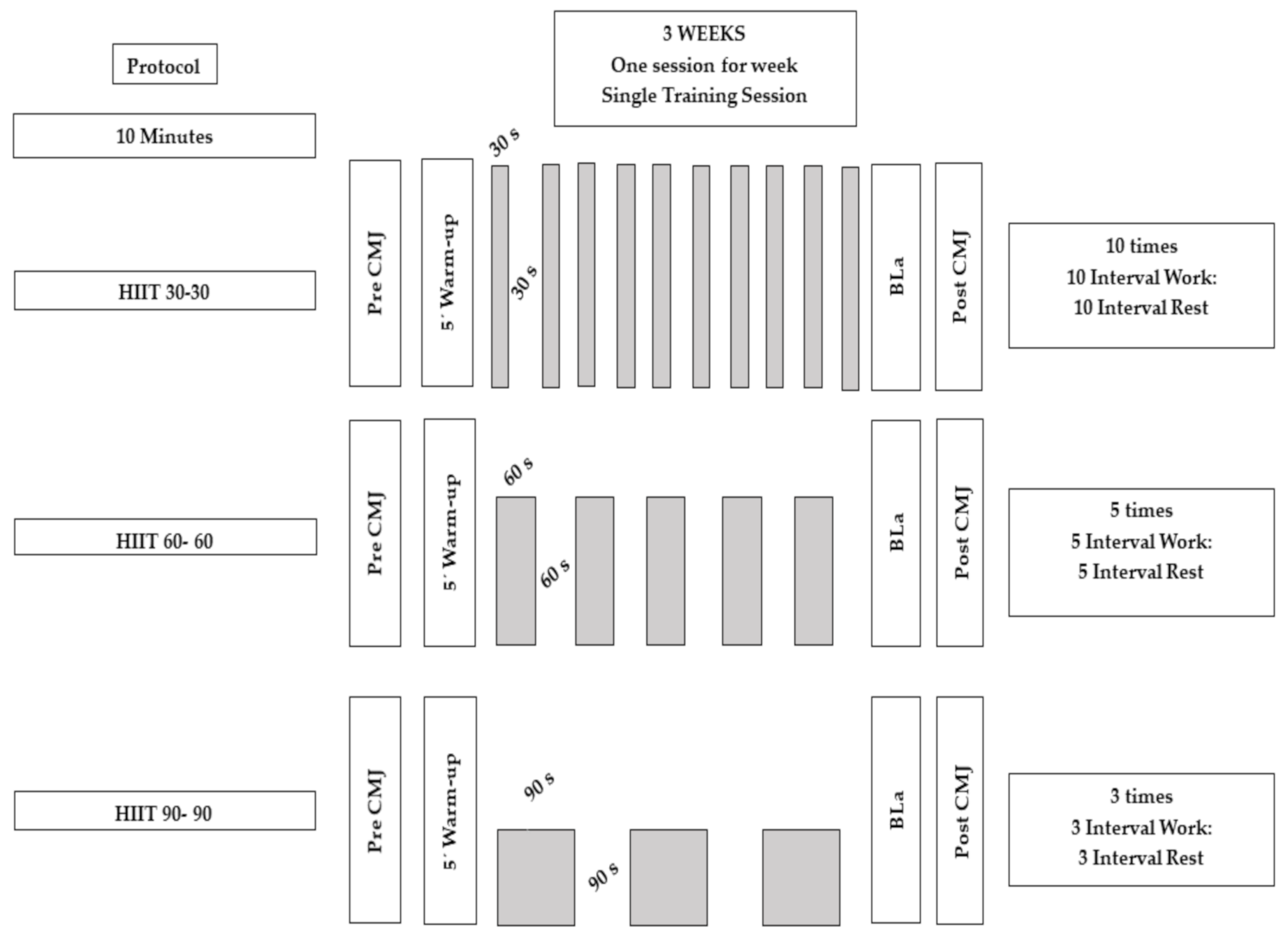
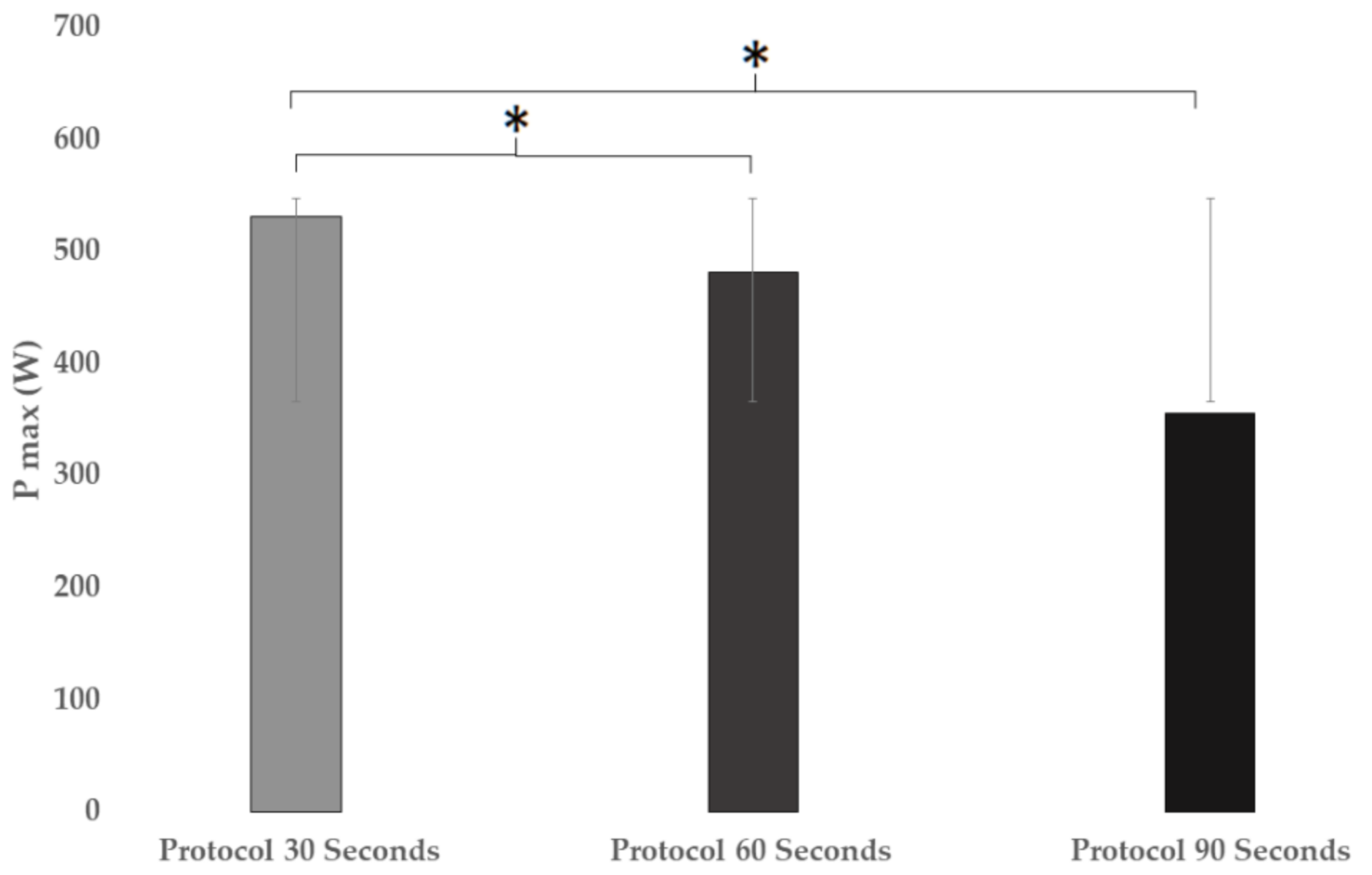
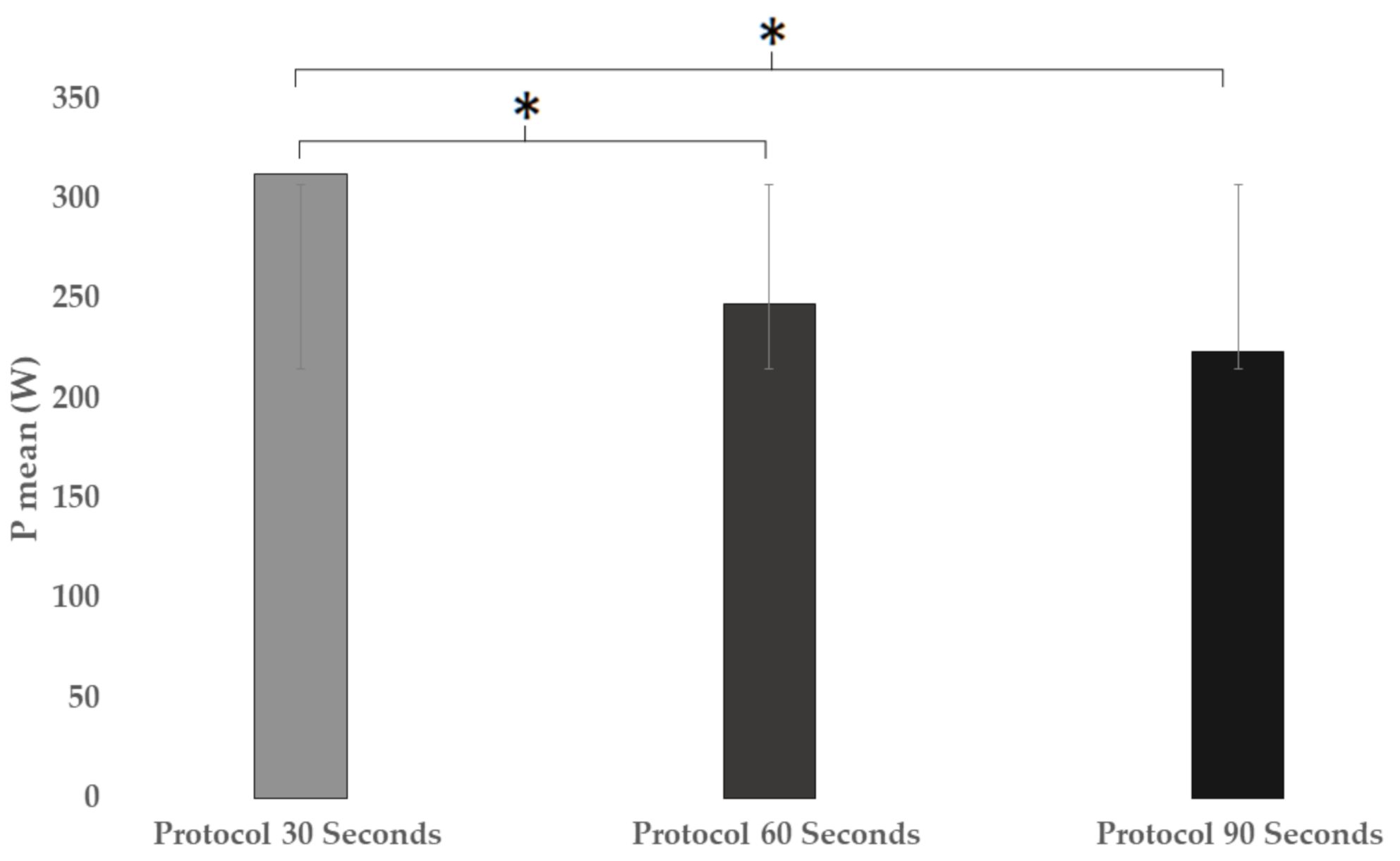
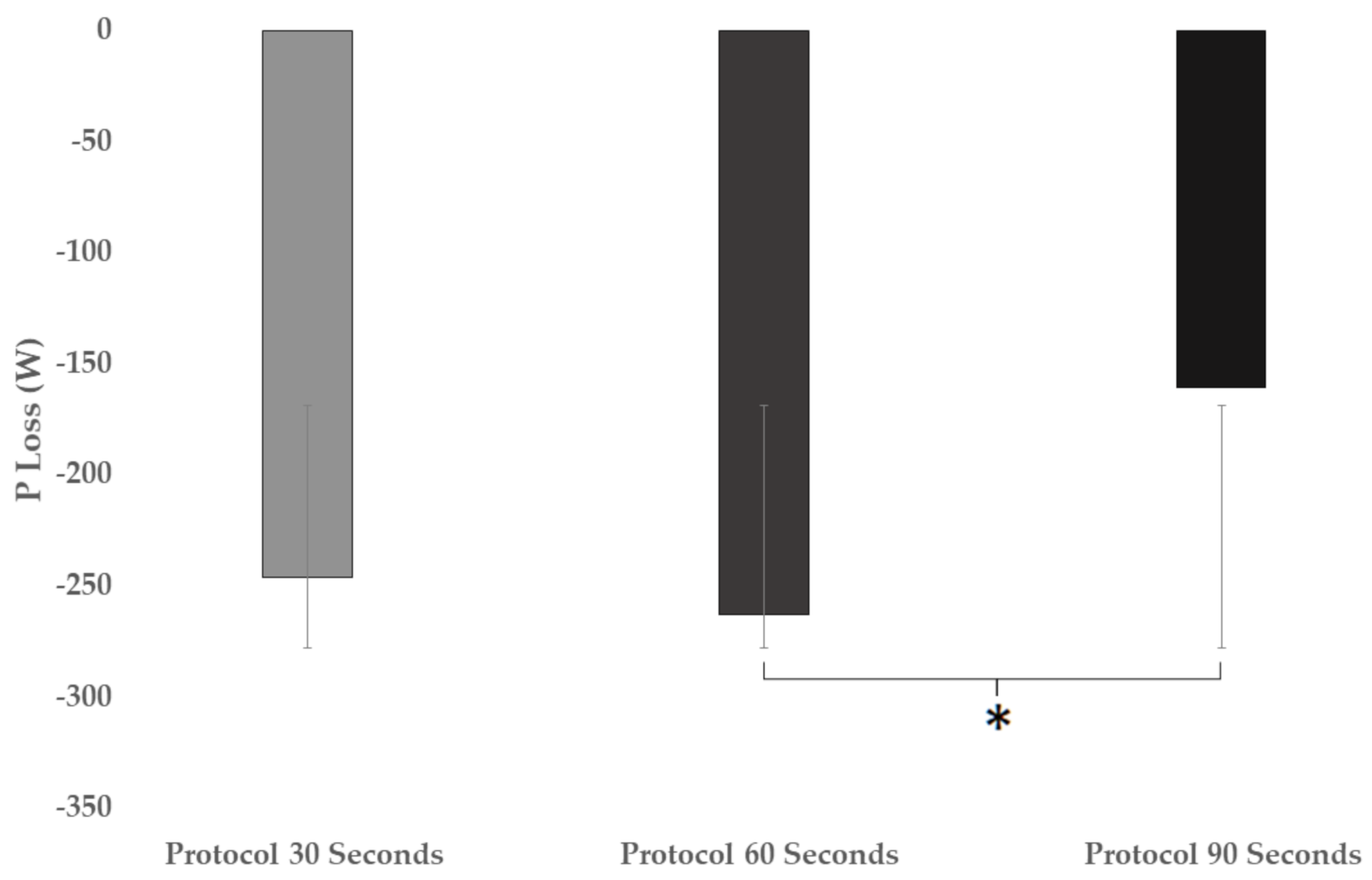
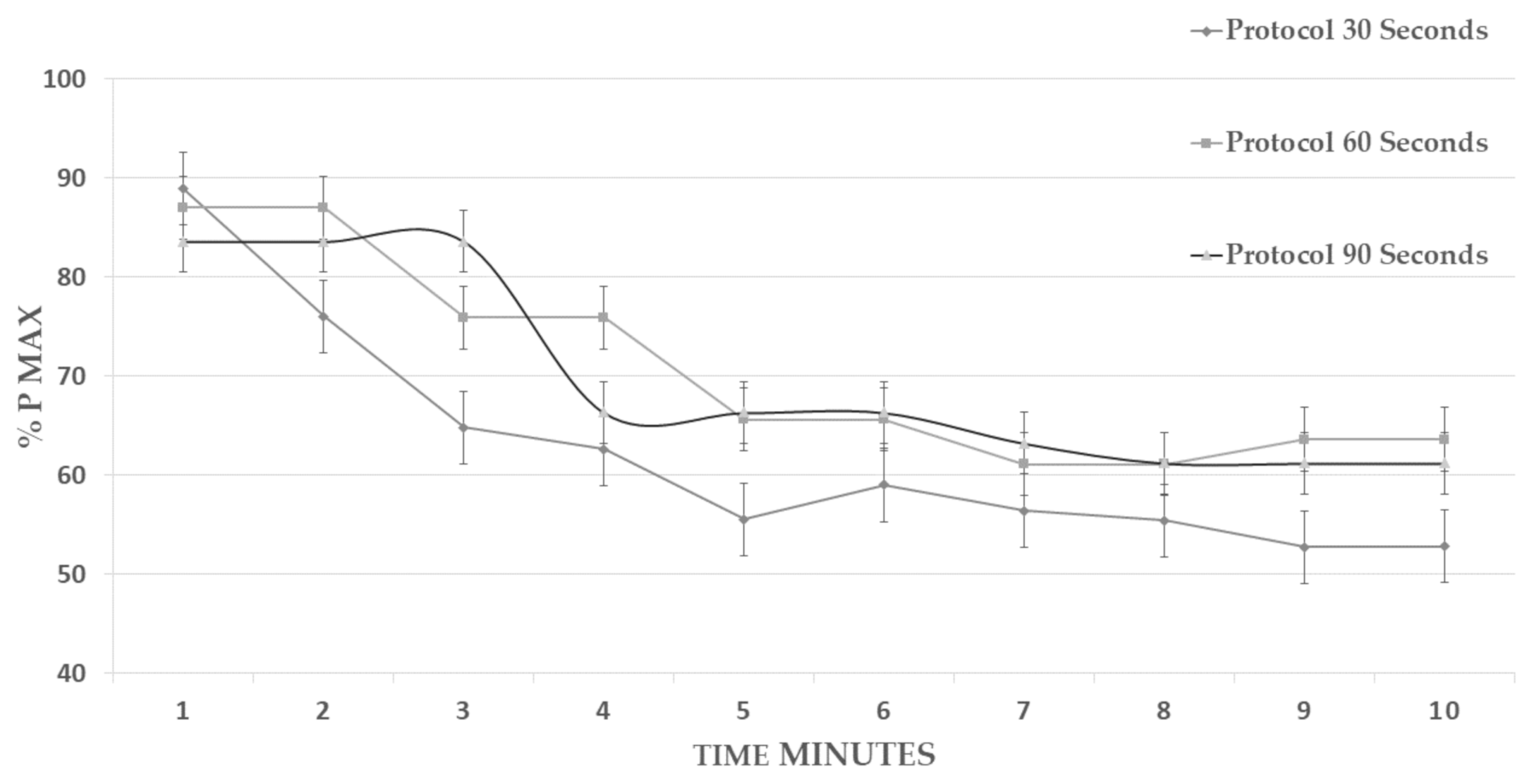
| Protocol High-Intensity Interval Training (HIIT) | 30 s | 60 s | 90 s | ||||
|---|---|---|---|---|---|---|---|
| PMC | X | SD | X | SD | X | SD | Sig. |
| LA (mmol/L) | 16.6 | ±0.6 | 15.9 | ±0.6 | 17.1 | ±0.60 | 0.373 |
| HRmean (b/min) | 175.4 | ±8.4 | 170.7 | ±6.2 | 165.8 | ±6.06 | <0.001 |
| Protocol HIIT | 30 s | 60 s | 90 s | ||||
|---|---|---|---|---|---|---|---|
| PME | X | SD | X | SD | X | SD | Sig. |
| IA CMJ (cm) | −4.6 | ±3.3 | −3.8 | ±3.6 | −3.75 | ±3.6 | 0.682 |
| IW CMJ (W/kg) | −2.9 | ±2.5 | −2.8 | ±2.9 | −2.37 | ±4.1 | 0.832 |
| Pmax (W) | 531.7 | ±168.9 | 481.9 | ±139.2 | 355.6 | ±104.7 | <0.001 |
| Pmean (W) | 312.6 | ±60.7 | 247.2 | ±54.1 | 223.4 | ±52.9 | <0.001 |
| Ploss (W) | −246.0 | ±188.5 | −262.9 | ±145.3 | −160.8 | ±68.8 | 0.047 |
Publisher’s Note: MDPI stays neutral with regard to jurisdictional claims in published maps and institutional affiliations. |
© 2021 by the authors. Licensee MDPI, Basel, Switzerland. This article is an open access article distributed under the terms and conditions of the Creative Commons Attribution (CC BY) license (https://creativecommons.org/licenses/by/4.0/).
Share and Cite
García-De Frutos, J.M.; Orquín-Castrillón, F.J.; Marcos-Pardo, P.J.; Rubio-Arias, J.Á.; Martínez-Rodríguez, A. Acute Effects of Work Rest Interval Duration of 3 HIIT Protocols on Cycling Power in Trained Young Adults. Int. J. Environ. Res. Public Health 2021, 18, 4225. https://doi.org/10.3390/ijerph18084225
García-De Frutos JM, Orquín-Castrillón FJ, Marcos-Pardo PJ, Rubio-Arias JÁ, Martínez-Rodríguez A. Acute Effects of Work Rest Interval Duration of 3 HIIT Protocols on Cycling Power in Trained Young Adults. International Journal of Environmental Research and Public Health. 2021; 18(8):4225. https://doi.org/10.3390/ijerph18084225
Chicago/Turabian StyleGarcía-De Frutos, José Manuel, Fco. Javier Orquín-Castrillón, Pablo Jorge Marcos-Pardo, Jacobo Á. Rubio-Arias, and Alejandro Martínez-Rodríguez. 2021. "Acute Effects of Work Rest Interval Duration of 3 HIIT Protocols on Cycling Power in Trained Young Adults" International Journal of Environmental Research and Public Health 18, no. 8: 4225. https://doi.org/10.3390/ijerph18084225
APA StyleGarcía-De Frutos, J. M., Orquín-Castrillón, F. J., Marcos-Pardo, P. J., Rubio-Arias, J. Á., & Martínez-Rodríguez, A. (2021). Acute Effects of Work Rest Interval Duration of 3 HIIT Protocols on Cycling Power in Trained Young Adults. International Journal of Environmental Research and Public Health, 18(8), 4225. https://doi.org/10.3390/ijerph18084225









